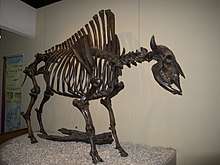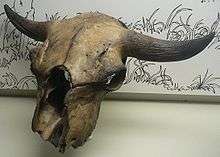Bison antiquus
| Bison antiquus | |
|---|---|
 | |
| Bison antiquus | |
| Scientific classification | |
| Kingdom: | Animalia |
| Phylum: | Chordata |
| Class: | Mammalia |
| Order: | Artiodactyla |
| Family: | Bovidae |
| Subfamily: | Bovinae |
| Genus: | Bison |
| Species: | †B. antiquus |
| Binomial name | |
| Bison antiquus | |
Bison antiquus, the ancient or antique bison, is an extinct species of bison that lived in North America until around 10,000 years ago. It was one of the most common large herbivores on the North American continent during the late Pleistocene, and is a direct ancestor of the living American bison.[3]
Biology
During the later Pleistocene epoch, between 240,000 and 220,000 years ago,[4][5][6] steppe wisent (B. priscus) migrated from Siberia into Alaska across the Bering Land Bridge. Bison priscus inhabited northern North America throughout the remainder of the Pleistocene. In western North America, B. priscus evolved into long-horned bison, B. latifrons, which then evolved into B. antiquus. The larger B. latifrons appears to have died out by about 20,000 years ago. After the extinction of B. latifrons, B. antiquus became increasingly abundant in parts of midcontinent North America from 18,000 ya until about 10,000 ya,[5] after which the species appears to have given rise to the living species, B. bison.[7] B. antiquus is the most commonly recovered large mammalian herbivore from the La Brea tar pits.[3]
B. antiquus was taller, had larger bones and horns, and was 15-25% larger overall than modern bison. It reached up to 2.27 m (7.5 ft) tall, 4.6 m (15 ft) long, and a weight of 1,588 kg (3500 lb).[8] From tip to tip, the horns of B. antiquus measured about 3 ft (nearly 1 m).

One of the best educational sites to view in situ semifossilized skeletons of over 500 individuals of B. antiquus is the Hudson-Meng archeological site operated by the U.S. Forest Service, 18 miles (29 km) northwest of Crawford, Nebraska. A number of paleo-Indian spear and projectile points have been recovered in conjunction with the animal skeletons at the site, which is dated around 9,700 to 10,000 years ago. The reason for the "die-off" of so many animals in one compact location is still in conjecture; some professionals argue it was the result of a very successful paleo-Indian hunt, while others feel the herd died as a result of some dramatic natural event, to be later scavenged by humans. Individuals of B. antiquus of both sexes and a typical range of ages have been found at the site.[9][10][11]
According to internationally renowned archaeologist George Carr Frison, B. occidentalis and B. antiquus, an extinct subspecies of the smaller present-day bison, survived the Late Pleistocene period, between about 12,000 and 11,000 years ago, dominated by glaciation (the Wisconsin glaciation in North America), when many other megafauna became extinct.[12] Plains and Rocky Mountain First Nations peoples depended on these bison as their major food source. Frison noted that the "oldest, well-documented bison kills by pedestrian human hunters in North America date to about 11,000 years ago."[13]
References
- ↑ Leidy & 1852a 117.
- ↑ Leidy, 1852b & 11.
- 1 2 "Animals of the La Brea Tar Pits Timeline". La Brea Tar Pits & Museum. Retrieved 14 March 2017.
- ↑ Bell, C.J.; et al. (2004). "The Blancan, Irvingtonian, and Rancholabrean mammal ages". In Woodburne, M.O. Late Cretaceous and Cenozoic Mammals of North America: Biostratigraphy and Geochronology. New York: Columbia Univ. Press. pp. 232–314. ISBN 0-231-13040-6.
- 1 2 Scott, E.; Cox, S.M. (2008). "Late Pleistocene distribution of Bison (Mammalia; Artiodactyla) in the Mojave Desert of Southern California and Nevada". In Wang, X.; Barnes, L.G. Geology and Vertebrate Paleontology of Western and Southern North America. Los Angeles: Natural History Museum of Los Angeles County. pp. 359–382.
- ↑ Sanders, A.E.; R.E. Weems & L.B. Albright III (2009). "Formalization of the mid-Pleistocene "Ten Mile Hill beds" in South Carolina with evidence for placement of the Irvingtonian–Rancholabrean boundary". In Albright III, L.B. Papers on Geology, Vertebrate Paleontology, and Biostratigraphy in Honor of Michael O. Woodburne. Flagstaff: Museum of Northern Arizona. pp. 369–375.
- ↑ Wilson, M.C. & L.V. Hills, B. Shapiro (2008). "Late Pleistocene northward-dispersing Bison antiquus from the Bighill Creek Formation, Gallelli Gravel Pit, Alberta, Canada, and the fate of Bison occidentalis". Canadian Journal of Earth Sciences. 45 (7): 827–859. Bibcode:2008CaJES..45..827W. doi:10.1139/E08-027.
- ↑ http://www.warkworthwesternweekend.com/competitors.php
- ↑ Davis & Wilson 1978, p. 128.
- ↑ Davis, L.B. and Wilson, M. (1978) "Bison procurement and utilization: A symposium," Plains Anthropologist. Volume 23, Issue 82, Part 2. p 128.
- ↑ Agenbroad, L.D. (1978) The Hudson-Meng site: an Alberta bison kill in the Nebraska high plains. University Press of America.
- ↑ Ehlers & Gibbard 2004.
- ↑ Frison 2000.
Further reading
- Davis, L. B.; Wilson, M. (1978), "Bison procurement and utilization: A symposium", Plains Anthropologist Part 2, 23 (82)
- Ehlers, J.; Gibbard, P.L. (2004), Quaternary Glaciations: Extent and Chronology 2: Part II North America, Amsterdam: Elsevier, ISBN 0-444-51462-7
- Frison, George C. (August 2000), Prehistoric Human and Bison Relationships on the Plains of North America, Edmonton, Alberta: International Bison Conference
- Leidy, Joseph (1852a), "Bison antiquus", Proceedings Academy of Natural Science, 6: 117
- Leidy, Joseph (1852b), Memoir on the extinct species of American ox, retrieved 20 September 2013
External links
| Wikimedia Commons has media related to Bison antiquus. |
- Conrad, Jim. "Ancient Bison foot fossil". The Loess Hills of the Lower Mississippi Valley. Backyard Nature. Retrieved 19 September 2013.
- Paleobiology Database - Bison antiquus